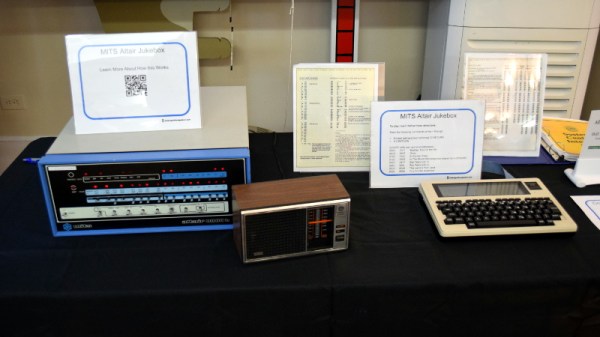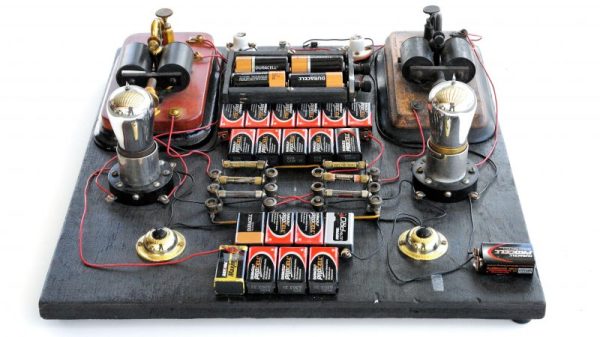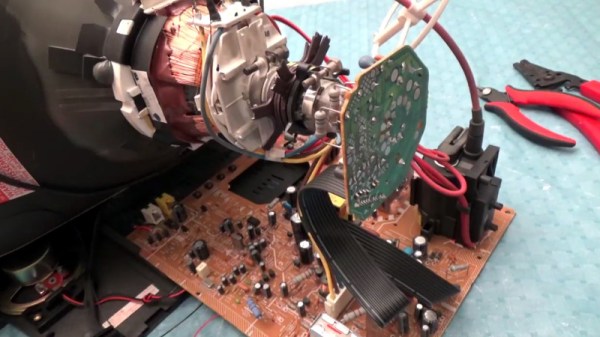You’d be forgiven if you thought software defined radio (SDR) was a relatively recent discovery. After all, few outside of the hardcore amateur radio circles were even familiar with the concept until it was discovered that cheap USB TV tuners could be used as fairly decent receivers from a few hundred MHz all the way up into the GHz range. The advent of the RTL-SDR project in 2012 brought the cost of entry level SDR hardware from hundreds of dollars to tens of dollars effectively overnight. Today there’s more hackers cruising the airwaves via software trickery than there’s ever been before.
classic hacks2788 Articles
Space Invaders Sound Chip Went Old School With I2L
It must be everyone’s birthday today because [Ken Shirriff] has come out with a gift for us. He’s done another pass at reverse engineering the 76477 Space Invaders sound chip from the 1970s and found it’s full of integrated injection logic (I2L), making it a double treat: we get to explore the more of this chip which made sounds for so many of our favorite games, and we explore a type of logic which was to be the successor to TTL until CMOS came along.
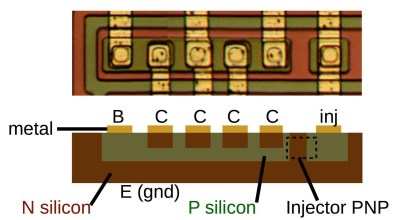
This article has a similar shape to his last one, first introducing I2L, followed by showing us what it looks like on the die, and then covering the different functional elements which make heavy use of it. The first of these is the noise generator made up of a section of shift registers and a ring oscillator. That’s followed by a noise filter which doesn’t use I2L but does use current mirrors. And lastly, he talks about the mixer which mixes output from the noise generator and elements covered in his previous article, the voltage-controlled oscillator, and the super-low frequency oscillator. Oddly enough, and as he points out, it isn’t an analog mixer. Instead, it just ANDs together the various inputs.
[Ken’s] no stranger to putting dies under the microscope. Check out our coverage of his talk at the 2016 Hackaday SuperConference where he shows us the guts of such favorites as the Z80 and the 555 timer IC.
Cracking The Case Of Capcom’s CPS2 Security
We love a good deep-dive on a specialized piece of technology, the more obscure the better. You’re getting a sneak peek into a world that, by rights, you were never meant to know even existed. A handful of people developed the system, and as far as they knew, nobody would ever come through to analyze and investigate it to find out how it all went together. But they didn’t anticipate the tenacity of a curious hacker with time on their hands.
[Eduardo Cruz] has done a phenomenal job of documenting one such system, the anti-piracy mechanisms present in the Capcom CPS2 arcade board. He recently wrote in to tell us he’s posted his third and final entry on the system, this time focusing on figuring out what a mysterious six pin header on the CPS2 board did. Hearing from others that fiddling with this header occasionally caused the CPS2 board to automatically delete the game, he knew it must be something important. Hackaday Protip: If there’s a self-destruct mechanism attached to it, that’s probably the cool part.
 He followed the traces from the header connector, identified on the silkscreen as C9, back to a custom Capcom IC labeled DL-1827. After decapping the DL-1827 and putting it under the microscope, [Eduardo] made a pretty surprising discovery: it wasn’t actually doing anything with the signals from the header at all. Once the chip is powered up, it simply acts as a pass-through for those signals, which are redirected to another chip: the DL-1525.
He followed the traces from the header connector, identified on the silkscreen as C9, back to a custom Capcom IC labeled DL-1827. After decapping the DL-1827 and putting it under the microscope, [Eduardo] made a pretty surprising discovery: it wasn’t actually doing anything with the signals from the header at all. Once the chip is powered up, it simply acts as a pass-through for those signals, which are redirected to another chip: the DL-1525.
[Eduardo] notes that this deliberate attempt at obfuscating which chips are actually connected to different headers on the board is a classic trick that companies like Capcom would use to try to make it harder to hack into their boards. Once he figured out DL-1525 was what he was really after, he was able to use the information he gleaned from his earlier work to piece together the puzzle.
This particular CPS2 hacking journey only started last March, but [Eduardo] has been investigating the copy protection systems on arcade boards since 2014.
[Thanks to Arduino Enigma for the tip.]
A 100th Birthday Celebration For The Flip Flop
It’s easy to get caught up in the excitement of creation as we’re building our latest widget. By the same token, it’s sometimes difficult to fully appreciate just how old some of the circuits we use are. Even the simplest of projects might make use of elements that were once a mess on some physicist’s or engineer’s lab bench, with components screwed to literal breadboards and power supplied by banks of wet-cell batteries.
One such circuit turns 100 years old in June, which is surprising because it literally is the building block of every computer. It’s the flip-flop, and while its inventors likely couldn’t have imagined what they were starting, their innovation became the basic storage system for the ones and zeros of the digital age.
Continue reading “A 100th Birthday Celebration For The Flip Flop”
Bringing Back A Spectrum’s Rails
The Sinclair ZX Spectrum was to most Brits the computer to own in the early 1980s, it might not have had all the hardware features of its more expensive competitors but it had the software library that they lacked. Games came out for the Spectrum first, and then other platforms got them later. If you didn’t have a rubber keyboard and a Sinclair logo, you were nothing in the playground circa 1984. That low price though meant that in true Sinclair tradition a number of corners had been cut in the little micro’s design. Most notably in its power supply, all the various rails required by the memory chips came from a rather insubstantial single-transistor oscillator that is probably the most common point of failure for these classic machines.
[Tynemouth Software] had an Issue 2 Spectrum with a missing -5V rail, and has detailed both the power supply circuit used on these machines and the process of faultfinding and repairing this one. A single transistor oscillator drives a little ferrite-spool transformer from which the various supplies are rectified and filtered. Similar circuits appear in multiple generations of Sinclair hardware, where we might nowadays use a little switching regulator chip.
We’re taken through the various stages of faultfinding this particular circuit, and the culprit is found to be a faulty Zener diode. It’s certainly not the last dead Spectrum that will cross an enthusiast’s bench, but at least in this case, the fault was less obtuse than they sometimes can be in this much-loved but sometimes frustrating machine.
Sinclair enthusiasts might also appreciate the great man’s earliest work.
Accurate Coffee Billing Through Reverse Engineering
If you’ve ever worked in a stingy office, you’ve become familiar with the communal coffee maker that runs on some variant of the honor system. There’s bits of paper, a coin jar shabbily sealed with sticky tape, and the routine note every six months telling people off for not paying for their daily brew. It all gets a bit much. Thankfully, if you work with [Fabian], it’s no longer a problem (PDF link).
The project forms the basis for [Fabian]’s thesis, in which a DeLonghi coffee maker is reverse engineered. This is undertaken with the explicit goal of properly metering the amount of consumables (coffee beans) used per beverage, to more fairly charge users depending on their brew of choice. This involves breaking down and understanding the coffee maker’s internal communications, as well as implementing a system to record and handle billing. For reasons of simplicity, [Fabian] decided that this should be handled using his colleague’s existing computer accounts. Easy!
It’s a highly academic approach to what we’re sure was a very stimulating project with lots of delicious aromas. Coffee’s a popular topic among hackers, that’s for sure – check out this roaster to take your game to the next level.
Convert A Curbside CRT TV Into An Arcade Monitor
While an old CRT TV may work well enough on a MAME cabinet project, the real arcade purists are quick to point out that a proper arcade monitor and a TV aren’t the same thing. A real arcade board uses RGB to connect to the monitor, that is, direct control over the red, green, and blue signals. Conversely video over coax or composite, what most people associate with old CRT TVs, combine all the video information down into an analog signal. Put simply, RGB allows for a much cleaner image than composite.
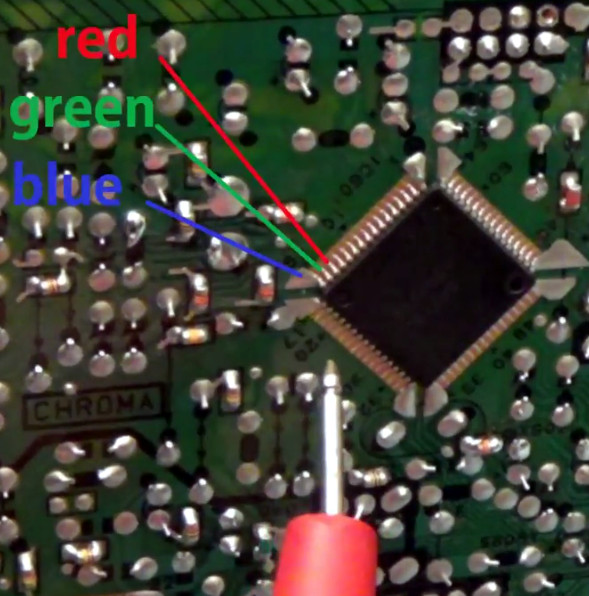 Many in the arcade restoration scene say that trying to convert a bog standard CRT TV into a RGB monitor isn’t possible, but [Arcade Jason] had his doubts. Over on his YouTube channel, he’s recently posted a tutorial on how to go from a trashed CRT TV to a monitor worthy of proper arcade gaming with relatively little work. As real arcade monitors are becoming increasingly rare, these kind of modifications are likely to get more common as coin-op gamers look to keep the old ways alive.
Many in the arcade restoration scene say that trying to convert a bog standard CRT TV into a RGB monitor isn’t possible, but [Arcade Jason] had his doubts. Over on his YouTube channel, he’s recently posted a tutorial on how to go from a trashed CRT TV to a monitor worthy of proper arcade gaming with relatively little work. As real arcade monitors are becoming increasingly rare, these kind of modifications are likely to get more common as coin-op gamers look to keep the old ways alive.
Now obviously every TV is going to do be different inside. All CRT TVs contain high voltages, and on some the circuit boards aren’t even mains-isolated, so take care if you try this. [Jason] certainly doesn’t claim that the method he demonstrates will work on whatever old TV you happen to have kicking around. But the general idea and some of the techniques he shows off are applicable to most modern TVs, and can help you tailor the method to your particular piece of gear. It all starts with a wet finger. Seriously.
[Jason] demonstrates a rather unique way of determining which pins on the TV’s control chip are responsible for the individual color signals by wetting his finger and sliding it over the pins. When a change in color is seen on the displayed image, you know you’re getting close. We can’t say it’s the most scientific or even the safest method, but it worked for him.
He then follows up with a jumper wire and resistor to find the precise pins which are responsible for each color, and solders up his actual RGB connection for the arcade board. In addition to the three color wires, a sync signal is also needed. This is the same sync signal used in composite video, so all that’s needed is to solder to the pad for the original composite video jack. Add a ground signal, and you’ve got yourself a proper RGB monitor.
Interestingly, this one has come full circle, as [Jason] says his attempt was inspired by an old post on Hackaday. It’s the Circle of Hacker Life.
[Thanks to Seebach for the tip]
Continue reading “Convert A Curbside CRT TV Into An Arcade Monitor”

